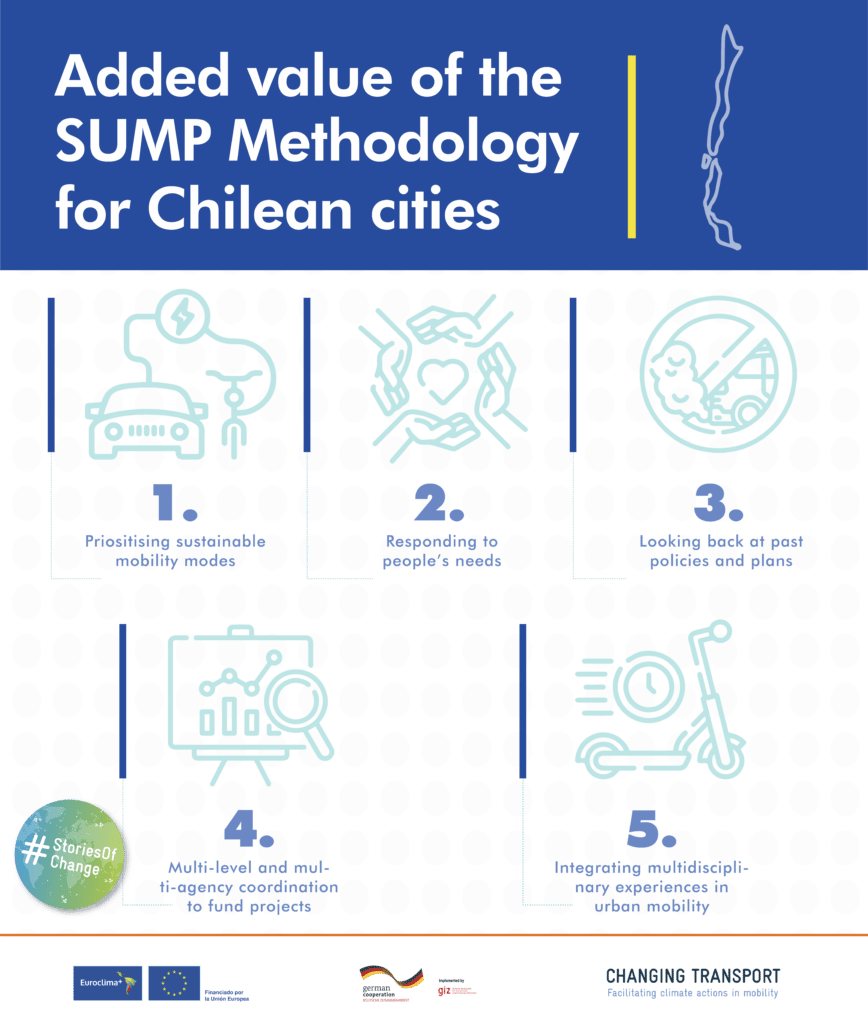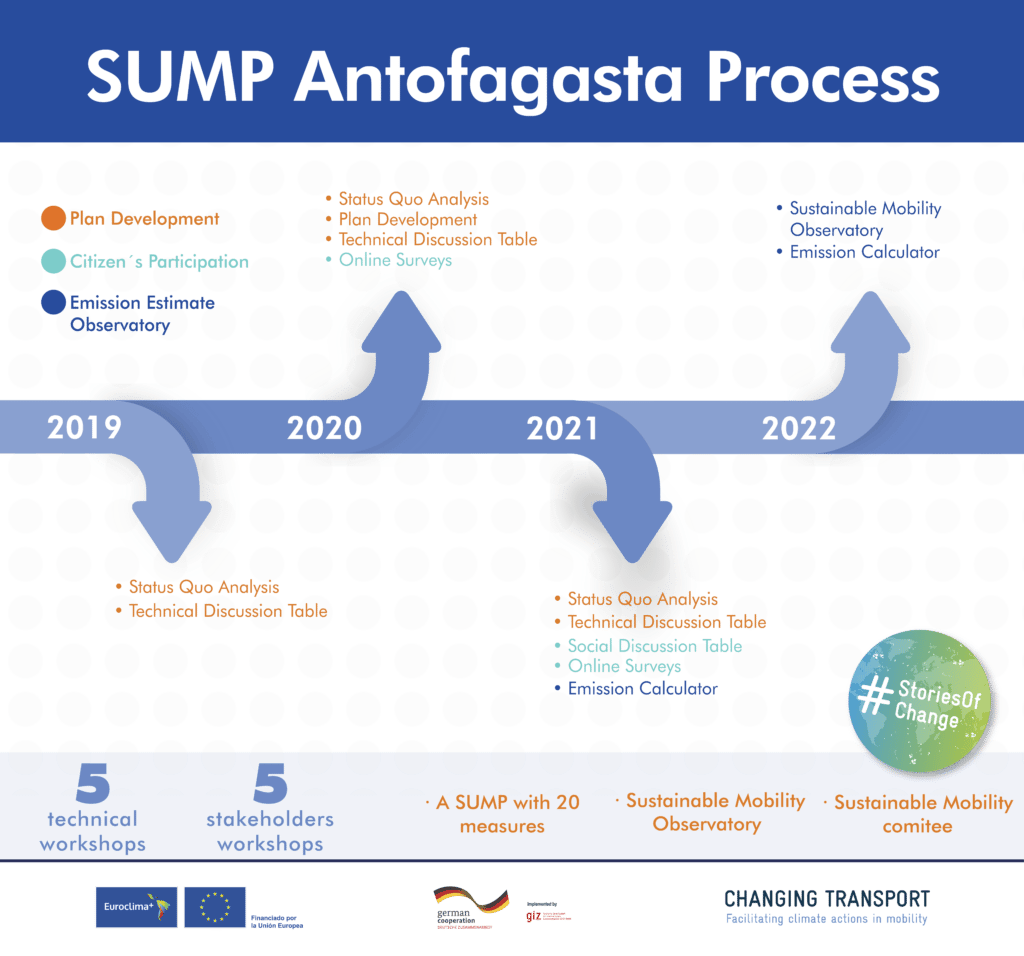
Since October 2018, as part of the EUROCLIMA+ programme, GIZ has supported the Regional Government of Antofagasta in developing a Sustainable Urban Mobility Plan (hereafter SUMP) for its capital city.
The development of this SUMP has been the first experience in designing a comprehensive sustainable mobility plan in Chile, including both motorised and non-motorised transport, focused on greenhouse gas emission reduction.
During the last 30 years, the national government has been developing urban transport system plans (hereafter STU) in more than 20 cities, focusing on time and fuel cost savings through almost exclusively infrastructure investment projects for cars and public transport.
While the Antofagasta SUMP development process is coming to a successful conclusion, like any first experience, it has had difficulties from which we can learn for the next SUMPs in other cities.
An initial difficulty in developing the Antofagasta SUMP was the limited participation of consultants in the bidding process, as Libelula (2022)1 analysed. Only one of the five Chilean consulting firms invited to bid presented itself. When reviewing the Terms of Reference (hereafter ToR) for the development of Antofagasta SUMP in search of the causes of this lack of participation, we can find some clues in the questions posed by the consultants during the bidding process. There were several questions primarily about the novel features of the SUMP method, contrasted to the STU method familiar to the consultants and the transportation modelling and evaluation task descriptions.
Regarding the SUMP method, the STU method should adopt five novel features because they add value to the Chilean current transport planning practice.
However, regarding transportation modelling and evaluation tasks, questions posed by consultants during the bidding process denote that they found that these descriptions were oversimplified, contrasted to the STU method.
According to the STU method, estimates of demand and benefits in terms of time, cost, and emissions savings are based on transportation models calibrated from travel surveys conducted to significant samples of 1% of households in each city. These models allow simulation of the balance between transportation supply and demand with different projects and measures and at future time cuts.
Each preliminary STU plan must be modelled and evaluated to find the optimal mix of projects and measures. In contrast, the SUMP method, at least as described in the ToR, requested the development of a modelling task with a general and oversimplified treatment that perplexed the consultants.


There is no simple model to estimate emission reduction from transport projects in different scenarios. Transport emissions result from a complex equilibrium process between demand and supply in at least four stages. Hence, the best alternative for emission estimates is using the already calibrated transport models the national government uses.
Transport modelling should not be an underestimated task in SUMP development; on the contrary, it has the potential to strengthen the technical analysis. Using modelling in SUMPs would be particularly relevant for analysing specific measures’ effects on emissions
For example, modelling could determine whether the potential users of a bikeway project are former car users, in which case emissions would be reduced or are from public transport, in which case emissions are not reduced, and demand for the latter mode is cannibalised from another sustainable mode.
While these transportation models have been used in STU to estimate demand and service levels of infrastructure projects, they can also be used to study other types of sustainable measures such as vehicle restriction with a daily pass, congestion pricing, low emission zones, transit-oriented development, bicycle lanes, pedestrian circuits, among others.
However, it is essential to note that these transportation models and evaluation methods should be improved to produce better estimates of the effect of cycling and pedestrian projects on travel demand and emissions.

In conclusion, the method for developing the next SUMPs in Chile should integrate the novel features from the SUMP and the best current practices and modelling tools already applied in Chile. The Regional Government of Antofagasta has understood this and, supported by Libelula (2022), has prepared the ToR for the development of the Calama (the second most populated city of this region) SUMP using this integrated method.
Integrating SUMP and STU methods is the first step toward synthesising both plans. Thus, instead of having two plans per city competing for financial resources, we should end up with only one plan having an optimal combination of sustainable measures to effectively reduce vehicle kilometers and emissions.
The process for designing this SUMP started in 2019 and ended in 2022. This process included planning development, citizen participation, and emission estimates.

The following seven sustainable mobility objectives were defined based on the insights from citizen participation and the technical discussion. These objectives relate to a wide range of Avoid, Shift and Improve instruments like reducing car use, increasing sustainable transport modes, and incorporating low-emission technologies.

To achieve these objectives, seven groups of actions were proposed. The investment in the SUMP priority actions was estimated at EUR 1.295 million along the 30-year time horizon of this SUMP.

Transport infrastructure actions were organised in both longitudinal and transversal sustainable mobility corridors, considering Antofagasta ‘s geographic structure. These corridors are shown in the following scheme and map.


The EUROCLIMA+ project is commissioned by the European Union and the German Federal Ministry for Economic Cooperation and Development (BMZ).
The Antofagasta Sustainable Urban Mobility Plan (SUMP) is part of the EUROCLIMA+ programme, funded by the European Union with technical assistance from the Deutsche Gesellschaft für Internationale Zusammenarbeit (GIZ) GmbH.
If you believe that you suffer (potential) negative social and/or environmental consequences from IKI projects, or wish to report the improper use of funds, to voice complaints and seek redress, you can do so using the IKI Independent Complaint Mechanism.